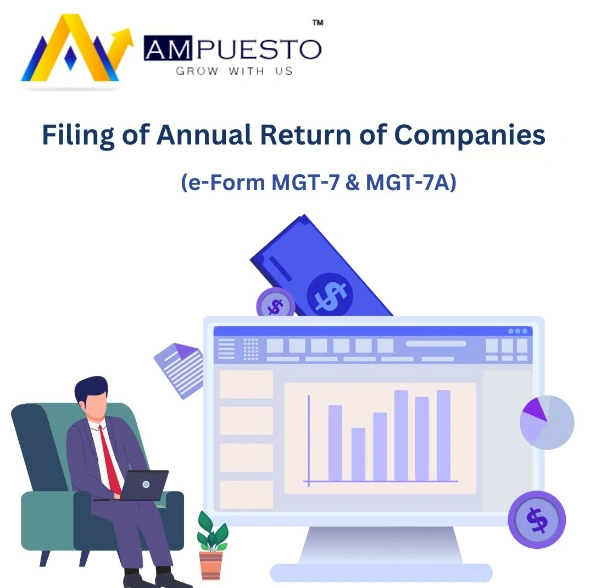Filing the Annual Return of Companies is a crucial compliance requirement for businesses in many jurisdictions, including India. In this article, we will delve into the intricacies of filing the Annual Return of Companies using e-Form MGT-7 and MGT-7A, with a particular focus on the innovative platform called AMpuesto. We will explore the significance of these forms, the process of filing, and how AMpuesto has streamlined this process, ensuring greater convenience and efficiency for businesses.
Understanding the Annual Return
The Annual Return of Companies is a comprehensive document that encapsulates vital information about a company’s financial health, management structure, and operational performance over a specific period. It provides stakeholders, including shareholders, regulators, and potential investors, with a clear snapshot of the company’s activities.
One of the primary purposes of the Annual Return is to promote transparency and accountability within organizations. By making this information publicly available, it enables informed decision-making and helps maintain the trust of investors and the general public in the corporate sector.
The Role of e-Form MGT-7 & MGT-7A
In India, the Ministry of Corporate Affairs (MCA) mandates the filing of Annual Returns by companies under Section 92 of the Companies Act, 2013. Companies are required to file this return in electronic form, commonly referred to as e-Form MGT-7. The e-Form MGT-7A is an attachment to MGT-7 and contains additional information concerning the company’s share capital and indebtedness.
Key Information Included in MGT-7 & MGT-7A:
- Financial Statements: The annual financial statements, including the Balance Sheet, Profit and Loss Account, and Cash Flow Statement, must be attached to the Annual Return.
- Shareholding Pattern: Details of the company’s shareholding pattern, including the names and addresses of shareholders and the number of shares held, are a critical component.
- Board and Committee Meetings: Information about board meetings, including the number of meetings held, directors in attendance, and the committees formed by the board, is essential.
- Compliance with Legal Requirements: Companies need to declare compliance with various statutory and regulatory provisions in their Annual Returns.
- Director’s Report: A director’s report, including the state of the company’s affairs and the reasons behind financial transactions, is a vital part of the Annual Return.
- Corporate Governance: Companies are required to disclose their adherence to corporate governance principles in the Annual Return.
The Filing Process
Filing the Annual Return using e-Form MGT-7 & MGT-7A is a detailed process, and companies must adhere to specific timelines to avoid penalties. Here is a step-by-step guide to the filing process:
- Gather Documents: Collect all the necessary financial documents, resolutions, and reports required for filling out the Annual Return.
- Register on MCA Portal: If your company is not already registered on the Ministry of Corporate Affairs (MCA) portal, you need to register first.
- Log In: Log in to your account on the MCA portal using your credentials.
- Navigate to e-Form MGT-7: On the portal, navigate to the ‘e-Form MGT-7’ section.
- Fill in the Details: Carefully fill in the details in the form, ensuring accuracy and completeness. Attach the required documents and reports.
- Verification: Review the information provided in the form, and ensure that it complies with all legal requirements.
- Payment of Fees: Pay the requisite filing fee based on the authorized share capital of the company.
- Submit the Form: Once all the information is accurately filled in, submit the e-Form MGT-7.
- Acknowledgment: After successful submission, you will receive an acknowledgment with a unique transaction number. Keep this number for future reference.
- Approval and Compliance: The MCA will process the filed Annual Return. If there are any discrepancies or missing information, they may request additional details or corrections.
- Approval and Filing of MGT-7A: If your company is required to file MGT-7A, follow a similar process for this form after the approval of MGT-7.
AMpuesto: Simplifying Annual Return Filing
AMpuesto is a revolutionary platform designed to simplify the process of filing the Annual Return of Companies. It offers several advantages, making compliance more accessible and efficient for businesses:
- User-Friendly Interface: AMpuesto boasts a user-friendly interface that simplifies the often complex process of filing Annual Returns.
- Error Reduction: The platform’s built-in checks reduce the likelihood of errors, ensuring that the submitted information is accurate and compliant.
- Document Management: AMpuesto helps in organizing and managing the required documents and reports, streamlining the attachment process.
- Timely Reminders: The platform sends timely reminders to companies, ensuring they meet the filing deadlines and avoid penalties.
- Secure and Encrypted: AMpuesto prioritizes data security, providing a secure and encrypted environment for sensitive financial information.
- Customer Support: The platform offers customer support and assistance, helping companies navigate any issues or questions they encounter during the filing process.
- Cost-Effective: By simplifying the filing process and reducing errors, AMpuesto can potentially save companies money that would otherwise be spent on compliance-related issues.
Conclusion
Filing the Annual Return of Companies through e-Form MGT-7 & MGT-7A is a critical compliance requirement that demands precision and timeliness. The innovative platform, AMpuesto, has emerged as a game-changer in simplifying this process, making it more accessible and efficient for businesses. By embracing technology and adhering to best practices in compliance, companies can ensure transparency, gain the trust of stakeholders, and foster a conducive business environment.
Filing the Annual Return is not just a legal obligation; it is a testament to a company’s commitment to accountability, governance, and transparency. With the right tools and knowledge, this process can be a straightforward and valuable exercise in corporate governance.









